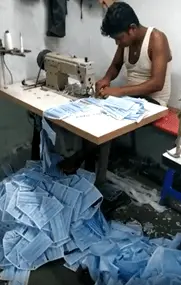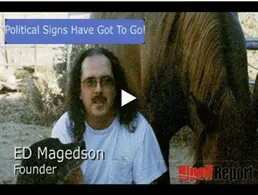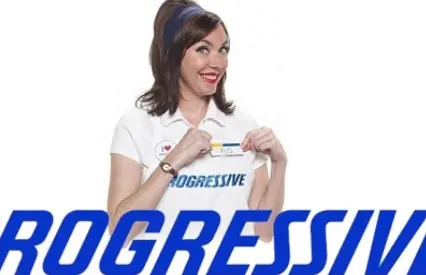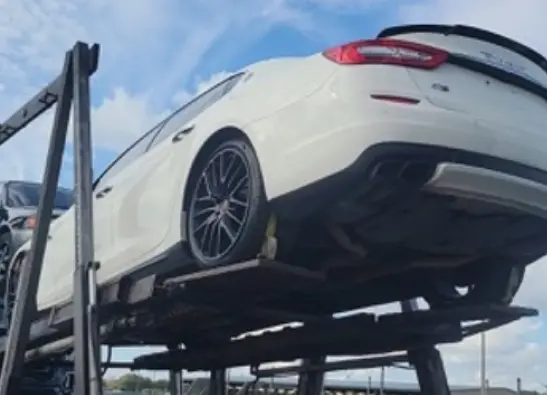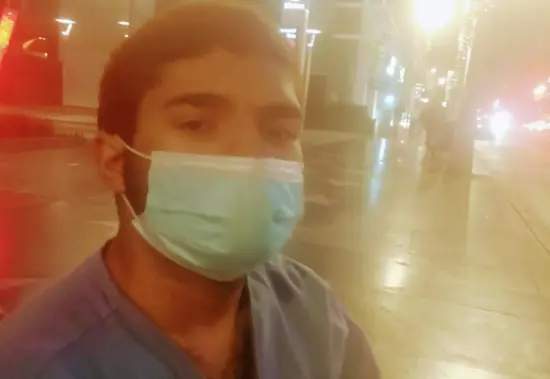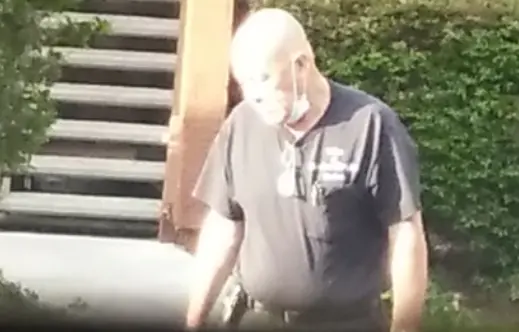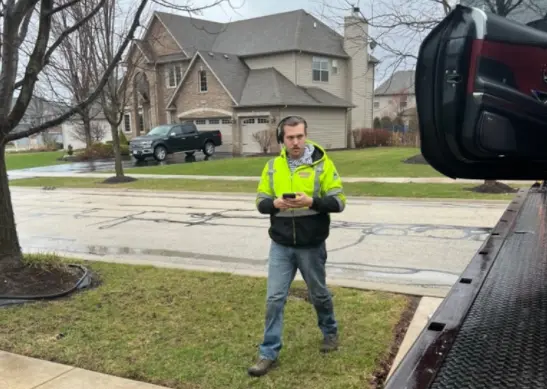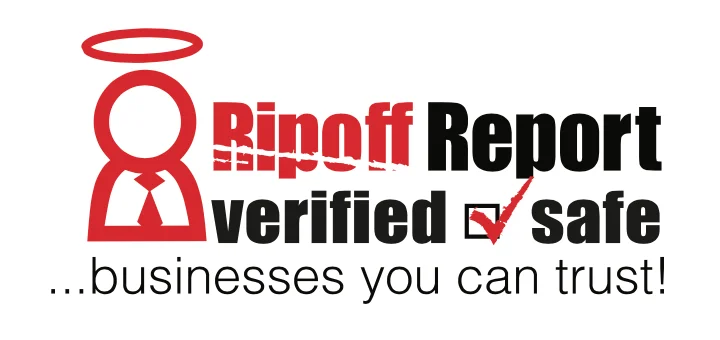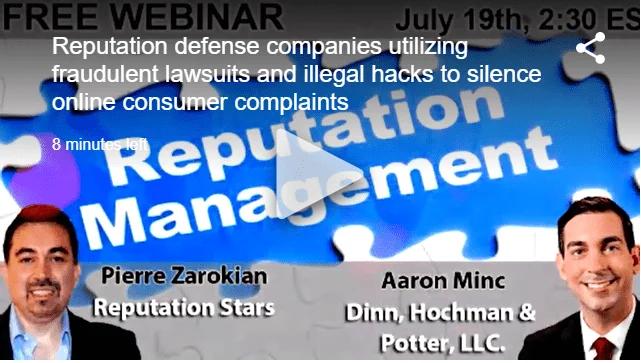INTRODUCTION
I began employment as a Wal-Mart truck driver on July 12th '87 with nine years of truck driving experience. I was wrongfully terminated on August 8th '98 with no: accidents, moving violations nor any late deliveries plus
I was accredited with being a team player and as a contributor to the Dispatch Office's backhaul revenue program. I was fired by the-then Dispatch Office manager (Brookhaven Ms) Paul Darwin out of his fear that my activities of advocating Company compliance of applicable law re the drivers being allowed opportunity to sustain proper sleep, every night, was putting his job in jeopardy, according to his statement to me. Officially, I was fired for refusal of a work assignment. And The Company's Open Door Policy was shut in my face (ie: Bentonville Transportation Mgt) because of my 6-year record of such crusading! At this same time
for those drivers who were willing to sustain Company-oriented sleep deprivation night after night after night (ie: just doing the job) many such-drivers could sustain multi serious truck accidents, get caught stealing, and other things yet such-drivers could hold onto their jobs!
The following Monday I made arrangements for an over-the-road driving job into the high turnover segment of the truck driving industry. I purposed not-to-take (or rather attempt to) a peer job to my Wal-Mart job doing the period of whatever time it would take to fight against my wrongful termination. So I made quick arrangements (which is all it takes in this sub-standard segment of the truck driving industry) for a replacement job with the exception that it would be three weeks prior to my starting (ie: three weeks for me to prepare a legal portfolio and shop it in my area. This I did but for several reasons I was only able to obtain a couple of legal interviews (one in Jackson and the other in Hattiesburg (Ms)). I was not successful in these efforts in winning an area litigation law firm, to my case, on a contingency basis.
However, during the weeks of putting my original legal portfolio together I discovered a driver's fatigue legal specialist by the name of Paul Taylor, operating as The Trucker's Justice Center out of Eagan Mn. Paul, though an attorney, was not a civil nor criminal litigation attorney.
He solicits truck driver wrongful terminations and pursues such cases in The Administrative Process (meaning that such judges and higher legalists are appointed by Presidential Administrations) in the Dept. of Labor under the 1982 Surface Transportation Assistance Act (STAA). Paul was recommended to me by a National highway (trucking) safety organization called Parents Against Tired Truckers (PATT).
I was referred to PATT by yet another such organization. I found out that PATT is operated by Mrs. Daphne Izer out of Lisbon Falls Me. (). A few years after my hire - Wal-Mart Transportation began to show
a certain video, a certain times, to its drivers at their Regions Dispatch Offices. This story is that, at this time, a trucker fell asleep while driving on the Me. Turnpike. He ran off The Interstate an onto the highway shoulder. He ran over an auto that was broken down at that very spot. It was occupied by 5 teens four of them died instantly one of them being Jeff Izer Mrs. Izer's son. This video included original local video of the crash and interviews with the surviving families and with the trucker and his wife. The rest-of-the-story is that the trucker was a Wal-Mart driver and Wal-Mart Transportation was using this film to impress the consequences of driving while sleepy to its drivers. Paul advised me to file a wrongful termination complaint with OSHA and as soon as OSHA denied my case he would begin the work that he does in appealing such cases to the DOL.
I filed a formal complaint with OSHA (Jackson Ms) in September with Field Investigator Johnny McDowell. He took-down my complain, by hand, my wife Janie being with me. In so many word's Johnny told me that a s****..
Under the appeal, The Administrative Review Board assigned my case to Judge Larry Price, out of The Office of Administrative Law Judges in Metairie La. Judge Price assigned a hearing date in Jackson Ms. Wal-Mart's (WM) Corporate Legal Dept. filed a brief for Summary Dismissal of my case. Paul Taylor filed a brief in opposition. Judge Price found (Recommended Decision and Order RD&O) for Wal-Mart and cancelled the hearing scheduled in Jackson Ms in July '99. Paul Taylor filed a brief against Judge Price's RD&O with the Administrative Review Board (ARB) in DC WM Legal filed a brief in-support of this RD&O. The ARB remanded Judge Price's RD&O and ordered the hearing to be reset.
The hearing was held at the end of Feb. '00 and a couple days into March. Judge Price was aggravated that he had to come to Jackson and conduct this hearing (to maintain his $100,000.00 per year salary) following his canceling of the original hearing. WM Legal had no competent defense of my wrongful termination complaint at this hearing. However to win such-a-case under the 1982 STAA the burden-of-proof is shouldered by the complainant. Its protective provisions (provisions that provide protection, for the employee, against the employer forcing the employee to operate the regulated motor vehicle in an impaired condition (impairment re either: the employee or the vehicle). The complainant must prove all three of three circumstances: 1) that no other separate action, worthy of termination, was engaged by the complainant; 2) that the complainant properly notified the employer of the impairment; and 3) that the impairment was real;
Paul Taylor (Paul) came down from Minnesota and stayed the weekend at my house in preparation for the hearing. WM Legal pursued duel motive ie: that I did engage in other activity worthy of termination (rudeness and abandoning the trailer) and that I did not properly notify the employer of the impairment. We proved all three aspects: 1) that I did not commit any separate act worthy of termination; 2) that I did properly notify the employer of the impairment (this was so-noted on one of their-own exhibits); and 3) that the fatigue was real (we had a sleep-expert and he testified that to have sustained a day's work into a accumulation of some 18 hour since last sleep one would be in the same condition as one legally-drunk and that to have napped for just a couple of hours and then retuned to duty to shuttle the trailers, for the store, one would-then be even more impaired!
WM Legal and Paul filed their briefs to Judge Price's office in support of their cases and then filed response briefs. Again Judge Price wrote his RD&O for Wal-Mart (June 14th 00). ALL of my case evidence was either tossed out (Judge Price excluded all the testimony of the sleep expert) or ignored. In other words Judge Price wrote his RD&O as if Paul and I did not show up for the hearing! I advised Paul that I would file my own brief against Price's RD&O before the ARB. Paul filed an Amicus brief (ie: friend of the court) with the ARB on-behalf of other existing fatigue cases that he had. WM Legal protested and the ARB tossed Paul's brief. At this point I fired Paul for two reasons: his incompetence re case prep. and argument (my opinion supported by The Record) and that he would have legal opportunity to refile his Amicus brief re his other truck-driver fatigue cases! This was my last contact with Paul except for a couple of months ago (explanation later).
In August of '01 the ARB wrote their Final Decision and Order (FD&O) for WM. The ARB, in their decision also ignored or tossed all of my case record evidence, as if I did not attend the hearing! I turned down the appeal because of its cursory nature. Since I've sent portfolio after portfolio to civil litigation law firms as leads would be mailed to me. While most-all such-qualified attorneys will jump over a picket fence for a case re some sleep-impaired trucker killing otherwise-innocent people hardly-a-law firm knows anything about the blatant lawlessness of trucking operations in-general (in-conjunction with Federal Corruption.
This file exists for two purposes: 1) for whosoever to know beyond any shadow-of-doubt that I was fighting Corporate lawlessness inside WM Transportation (all-of-which was known by the Dept. of Transportation (DOT) regulators) and 2) to bring to the light-of-day that day-to-day lawless criminality is standard fare for trucking operations (all-of-which is known by the DOT regulators).
Lastly WM neither muscled nor purchased, in any way, this case. This case was given to WM by Federal Corruption to protect OSHA from its failure to (years earlier) investigate America's most unsafe work environment that of the WM truck driver! Exhibits on Company letterhead will more-than-prove this charge!
THE WAL-MART WAREHOUSE SYSTEM
Mr. Sam Walton employed a rare but simple merchandising philosophy: customer and employee integrity are equally important and the most important of all merchandising considerations! After breaking-away from a 5 and dime chain store and going independent it was not long before this policy allowed him to open stores two and three and the rest is History! When his discount chain was big enough he had to devise a distribution system that would keep his stores properly stocked. He determined via experience and knowledge that he could more efficiently control the restocking of his stores if he owned the trucking operation rather than hire-out his trucking needs. This policy stands firm today though there exists 20 years of rumors that one trucking company or another was going to take over WM Transportation when not anything could have ever been further from the Truth!
I was hired into the Brookhaven Ms Warehouse and Dispatch system on July 12th '87. Brookhaven is warehouse no. 11. The warehouses are called Regional Distribution Centers (DCs) and all DCs have a functioning Dispatch Office that may or may not be physically-attached to the DC building but each DC complex has an operating Dispatch Office. The Dispatch Office (TDO or DO) is a separate entity working in partnership with the DC that all store loaded trailers reach their destinations on time 100 percent of the time!
The DC loads the store-destined loads in batches each batch could account for some 25 to 30 or more trailers.
When the DC releases a fully-loaded store trailer it is pulled off its dock loading door asap and replaced with the next empty. The DC prepares a packet for each store-destined trailer this packet containing a computer print-off of every item loaded (costs and retail info) and the shipping bills. Then it was normal for the DC to hand-deliver the packets to TDO that waiting drivers could-then leave on their respective runs and still-returning drivers (still on-the-road from last work assignment) would-not have-to wait for this paperwork. And this would continue throughout the day as the packets would have been delivered to TDO by batches. It would not be unusual for busy DCs to load 200 or more store trailers per day. And there is a constant relationship between how much freight the DC's receive and ship (ie: the DCs are not stock-piling warehouses they serve as transfer functions in getting received merchandise out, to the stores, asap.
TDOs have several basic functions some are: maintaining the pre-set delivery logistics with on-time deliveries every time (no matter what!); servicing and repairing the trucks and trailers; fueling the trucks; operate a consolidation dock whereby in-bound loads (outside drivers) and backhauls (Company drivers)
represent more than one DC on the same trailer then such-trailers must be emptied (at TDO centerpoint docks) and the freight consolidated in separate trailers whereby all-the-freight on such-trailers is destined for the same DCs; and office and Personnel support for the whole DO operation. Consequently many busy DOs may work some 300 to 500 employees!
For delivery logistics and schedule purposes there were two types of stores: 1) busy night-receiving stores and less busy stores called small stores (small relating only to store sales). Prior to the death of Mr. Sam Walton (an American loss) the busy stores unloaded their trailers at night to keep from staging so-much freight in the shopping aisles during prime shopping hours. Most of these stores had two docks and this time era is about 6 years prior to the advent of The SuperCenter. And the busy stores could receive more than one loaded trailer per receiving night. These loaded trailers were dropped in these stores' receiving docks, earlier in the day with these drivers returning to their respective DOs with the empty trailers from that night's receiving.
The less-busy stores received their freight on live unload routes. This means that the freight was unloaded while these drivers waited and anywhere from 3 to 5 (or more) stores could be on the same trailer (the WM Company driver did not participate in the live-unloading). It was typical for the first store to initiate unloading their part, of the trailer, at 0700 HRs. The driver may have arrived anywhere from 2100 HRs (that night) to the early morning hours though not usually later than 0100 to 0200 HRs. These drivers would be on 8-hour break (asleep in the truck bunks) after backing into the docks upon arrival. It was important that the drivers would have completed the legal requirements of the 8 hours (no matter how much or little sleep they got) prior to the first store finishing unloading their part that the drivers can immediately depart for the next stores (though even if these drivers did not arrive until later in the morning and they had hours left on their 8-hour break they would still be expected to immediately depart for the next store).
Mr. Sam's couple of stores based upon his unique customer and associate philosophy exploded into a small chain of discount stores and the explosion continued establishing a small National chain up to the point prior to his death whereby Wal-Mart Stores Inc. was America's largest merchandise retailer. This explosion continued to magnify (this explosion being Corporate Prosperity unparalleled in America) after his death. The National logistics to keep these stores restocked was mind-boggling (though the-then 5-year National boycott against K-mart re their Pornography profits from Walden Books did not hurt WM's cause!) A radically-new National delivery system was rolled out not long after his death.
Now all stores would have assigned trailers and many stores would have two assigned trailers. The busy stores would receive at-least one loaded trailer per receiving night (5 to 6 nights) many of these stores would receive two or more the same night (the Hattiesburg (MS) store being a good example those years prior to the advent of The Supercenter this store receiving up to 4 loaded trailers the same night with two docks!). These stores' first one or if more than one for the same receiving night or two trailers would be dropped in earlier in the day with these drivers picking up the empties (the assigned trailer(s)) from the previous nights' receiving.
The overflow loads ie: more trailers for the same receiving night than the stores have docks to accommodate
would have to be shuttled into the dock at some point earlier in the morning (after Midnight).
Every 6 months at Realignment time stores could adjust their receiving times. The first purpose of Realignment was reshuffle the outer stores more efficiently with the DCs. Each year or so one or two new DCs were coming on-line (just one DC complex is a hugh investment). Gradually the DC's operating radius was trimmed from 500 miles to 450 miles to 400 miles etc. and etc. Realignment allowed the most efficient use of each DC regarding average distance to their stores. Also the busy stores could alter their otherwise set time to initiate receiving re their first trailer for that night. These stores could initiate receiving at: 2100 Hrs, 2200 HRs, 2300 HRs or at Midnight. Once the choice was made it was set for 6 months till next Realignment! This was the basis for non-chaotic delivery logistics. These stores had two hours to unload each trailer no matter what.
The less-busy stores had no such-choices. They were on an automatic schedule to receive two loaded trailers twice a week on Tuesdays and Thursdays. Unloading would begin at 0400 HRs and these stores had 4 hours to unload their trailers. Many of these stores had only one dock and would receive two trailers the same receiving night. In that case the empty must be pulled out of the dock and the next one docked by 0800 HRS. This also would be an overflow load case as when the delivering driver arrived usually between Midnight and 0400 HRS the dock would be already covered by the first trailer its unloading not-to-commence until 0400. As one should be able to see it is how WM decided to handle the overflow loads that became one of their
drivers two nightmares. This will be fully explained later. When these stores began to routinely-receive more than one trailer the same receiving night they became eligible to be converted to the status of being a busy store.
A good example was the store at Gonzales La. This was a typical one-dock two-night per week receiving store.
Gonzales began to receive extra trailers on both Tuesday and Thursday nights (TC's unparalleled National Prosperity). TC made an investment in building a second receiving dock at Gonzales. Gonzales went from being a small store to a busy store (more common than rare). Soon TC's National Prosperity expanded Night Receiving from 5 night to 6 nights and perhaps by now 7 nights. The busy stores were the first prospects to be converted to SuperCenters but many small stores were converted to SuperCenters without having ever been promoted to the status of busy stores a good example is the store at Kosciusko Ms.
Though TC never officially named this new National Delivery System the word custom was most used regarding it. Throughout the legal process I referred to this system by the most correct title possible: The Custom Night Receiving System (TCNRS) and it will be so-referred to throughout this file. That radical change was necessary was a fact mandated by TC's unparalleled National Prosperity. And that TCNRS kept the stores restocked to Company expectations is also a fact. For all these years TCNRS seemed to have operated as if it were fine-oiled machinery! And the drivers were the oil of this machinery!
In recap TCNRS allowed the busy stores to set their initial unloading time, for their first trailers, from 2100 HRS to Midnight, allowing two hours to unload all scheduled DC trailers consequently all overflow DC trailers (more loaded trailers the same receiving night than the stores had docks to accommodate at one time) were scheduled to be unloaded on 2-hour intervals. The busy stores would receive at-least one loaded trailer per Dispatch-day (then 6 days per week). The small stores (overwhelmingly one-dock stores) would receive at least one DC loaded trailer at 0400 HRs on Tuesdays and Thursdays being allowed 4-hours to unload consequently-sequencing overflow DC trailers every four hours. TCNRS was originated to best maintain store resupply in-answer to this pressure that America's greatest case of Corporate Prosperity was applying to TC. In no way was the implementation of TCNRS consequently to Mr. Walton's (a Great America) death. Armies lose wars because of their inability to maintain field resupply Wal-Mart purposed not-to-lose this war by-being America's (and this World System's) leading discount merchandiser hence TCNRS!
THE DOT REGULATIONS RE THE USING OF REGULATED DRIVERS HOURS TO WORK
The Federal Dept. of Transportation's rules and regulations that commercial truckers are subject-to are over 50 years old. Trucking has changed, in so many ways, in this time (some are: legal lengths and weights, trailer types, highways, metro-area truck accesses, how truckers rest, average length of hauls and truck-cab comforts) that the current regs are outmoded. The three regulations regarding their hours to work that commercial drivers are subject-to are:
1) THE TEN HOUR RULE:
Commercial truckers are permitted to drive for 10 hours following 8 consecutive hours of uninterrupted rest (the regs do not call rest sleep yet - without proper sleep truckers drive sleepy putting the driving public at-large at great risk and sleepy truckers are responsible for the greatest number of big rig accidents).
2) THE FIFTEEN HOUR RULE:
Commercial truckers may no longer drive after accumulating a total of 15 hours of on duty work-time
until sustaining an 8 consecutive hours of uninterrupted rest (there are no Federal regs regarding how
many hours working but not driving that commercial truckers can be made to work).
3) THE SEVENTY HOUR RULE:
If the trucking company is a seven-day per week operation its drivers cannot sustain more than 70
hours of total hours on-duty: driving hours plus hours working but not driving in any eight consecutive
day period (7 consecutive days for non seven-day per week trucking operations).
That these three rules regulating how the legal available hours of commercial truckers can be legally used are outmoded is an uncontested fact between: the trucking companies, the drivers and the DOT regulators. How to properly reissue new regulations is where all involved parties are in disagreement. This disagreement is so contentious that the DOT regulators are in-violation of a Public Law that mandated that the new rules be issued over three years ago! At the heat of this contention is the issue of the trucker's sleep.
When a trucking operation assigns one of its drivers a run this work assignment must be within the context of the three rules to be a legal work assignment. For too many years the DOT regulators have allowed trucking companies to notate that the work assignment is safe if it is legal. However legal does not mean safe regarding trucking work assignments nor has the legality of any trucking work assignment ever been assigned the weight of the meaning of safe! The trucking work assignment must be legal to be assigned to a commercial trucker but there is other criteria that determines whether the work assignment is safe or not.
Some of these factors are: whether the driver is properly-rested (rest meaning sleep); the mechanical condition of the truck; the mechanical condition of the trailer; and that the load can be properly secured. Who can say which situation is most dangerous: truckers-driving-sleepy or trucks and trailers in unsafe condition. for argument's sake let us say that trucking companies do not put unsafe trucks and trailers on-the-road (which is a false statement) consequently the most notable issue in trucking is whether or not the driver is properly-rested or driving-while-sleepy!
An 8-hour rest break can be properly notated on the driver's log book (having actually occurred as logged) yet the driver may not be properly-rested. The logistics of the work assignment may force the driver to take an 8-hour rest-break during a clock-time period when sleep is not biologically-possible. A driver could be out-of-driving hours at High Noon and the delivery logistics mandate an 8-hour break from High Noon to 2000 HRs (the typical driver may get 2 hours sleep out of this scenario but the delivery logistics mandate that this driver drive from 2200 HRs to 0400 HRs (thru the Midnight hours) this driver will, without any doubt drive while sleepy for many hours! And, this driver has no real protection from being forced to so-drive sleepy by the trucking company! The trucking companies, behind the scene, maintain that they cannot financially-afford to provide 8-hour breaks at times convenient for sleep!!! The consequence is controlled highway mayhem committed by lawless trucking operations in-conjunction with Federal corruption!!!
THE WAL-MART DELIVERY SYSTEM: CORPORATE LAWLESSNESS IN-CONJUNCTION WITH
FEDERAL CORRUPTION
PART 1: WAKING UP SLEEPING DRIVERS TO SHUTTLE TRAILERS FOR THE STORES
The financial facts testify that Wal-Mart Stores Inc. (WM or The Company TC) has enjoyed a Corporate Prosperity beyond any comparison. Certainly the persona of Mr. Sam Walton is centerfold in this prosperity! This Corporate Prosperity has been passed on down to the stock-holders, time and time again regarding some six two for one stock-splits over the past 15 years. Whether they are in down times or on high grazing grounds Corporations are faced with problems every day of their existence some to the bad others to the good. Though much down-scaled the family unit or the local social club (ie: the local church) would make an analogy. It is not the problems that determine character it is how the problems are solved or handled that determines character! This will hold True for WM!
Prior to Mr. Walton's death (a great American and America's loss) one of the most prolific good problems was
that the stores were demanding more stock resupply than the stores had docks to accommodate (loaded trailers at the same time) and the Delivery System was competently-able to handle. After his death TC saw the advent of the new National delivery system called The Custom Night Delivery System however it is more appropriately referred to, throughout my 3-year DOL case, as The Custom Night Receiving System (TCNRS). At this time many of the busy (two-dock) stores and some of the small (one-dock) stores were already demanding more resupply than they had docks to accommodate at the same time. An overflow load is a DC store-loaded trailer whereby when the assigned driver arrives at the appropriate store the dock(s) is already covered by a loaded trailer. It is typical for such-a-driver to be out of driving-hours or nearly out upon arrival as the wait for an empty trailer terminates this drivers ability to continue driving.
To better understand overflow loads one must first understand how TCNRS uses its drivers' hours. Again re the 10 hour rule the driver can drive 10 hours following a legal (ie: the log book is so logged) 8-hour break (whether or not the driver has slept: enough, some, a little or not-at-all) whereby after the log-book usage of the current set of 10 hours the driver is out of hours until another 8-hour break is legally logged (whether or not the driver slept: enough, some, a little, or not at-all) whereby the driver can-then access another set of 10 hours-to-drive. The typical DC may service some 200 stores and the typical Dispatch Office (TDO or DO) many employ some 200 or more Company drivers.
Every WM driver, coming off 8-hour break, has access to a set of 10 hours to drive. TC's drivers can come off 8-hour break at: the stores, backhaul locations, truck stops, rest areas, at home and on and on. All these drivers returning to TDO following coming off 8-hour break will expire an appropriate amount of their 10 hours on the return trips. Some are returning from 1-hour out, others from: 2-hours, 3-hours, 4 hours out (etc. and etc.).
Whether they took their 8-hour break at: TDO, home or on-the-road they-all initiate 10 hours-to-drive following their 8-hour breaks. Those drivers who took their 8-hour breaks on-the-road will have an appropriate amount of hours left-to-drive following their return to their respective DOs. At this same time TCNRS generates more stores loads per day than TDOs have drivers. This situation is handled by the dispatching of doubles and triples.
A double (or a triple) is when the driver is assigned two store deliveries within the same set of 10 driving hours.
For example this returning driver took his-her 8-hour break at some location 160 miles away. Depending upon the various speed limits this driver should be able to make the return trip (to TDO) in 2 to 2 to 3 hours
let's say: 3 hours. At return to TDO this driver should typically-arrive between 1000 and 1200 HRs. Then this driver would have 7 hours left to drive. This driver's first load could be 2 to 3 hours out let's say 2
hours out. This would be an automatic drop and hook. This driver would exchange the loaded trailer he-she is delivering for one emptied the previous night. This is called shuttling the trailers (STT) by the DOL throughout the legal case. By the time the driver shuttles the trailers (STT) and completes the round trip (5 hours) this driver will have 2 hours left to drive (10 hrs 3 hrs (initial return that morning) 5 hrs (this round trip) = 2 hrs left to drive. This driver's 2nd load-assignment would be to a store that is no-more than 2 hours out but would use either all or as much-as-possible of the remaining two hours.
Triples is when the driver has two drop and hooks and the final load assignment TDO using all or as much-as-possible of the driver's 10 hours. To better explain this many costs of the truck are static or level ie: the same costs month after month (diesel fuel being a cost contingent to how many miles the truck is driven. The static costs are most efficiently dealt with when dispatch logistics consistently uses the driver's 10 hours each day. At this same time the driver's mileage and activity based pay is maximized when TDO so-uses his-her hours. A ten-hour driving work day can produce 500 to 600 miles and based upon WM's activity pay of: doubles, triples, backhauls, 8-hr rest breaks, changing trailers and wait-time such-a-work day would generate somewhere around $300.00 (or more).
The driver's final (or could be the only one) work assignment for the day will terminate this driver's driving at-arrival at the destination and initiate the 8-hr break. Whether it is a driving with 8-hrs left-to-drive assigned to a store-run 8 hrs away or a driver with 2 hrs to run assigned to store-run 2 hrs away it is the same thing: either driver is out of hours upon arrival at their destinations. These are the drivers that are assigned the overflow loads. There are two issues with the overflow loads: 1) how many times the same work week the WM driver can expect to catch one and 2) how long, after store-arrival, will the driver have to wait for an empty trailer.
What labels an overflow load to be an overflow load is that by Dispatch logistics there will be no available dock to STTs when the driver arrives at the appropriate store.
Typically re the former: overflow loads could be thirty or more percent of that day's deliveries for that DO. WM attorneys, Paul Taylor (representing my case) and The DOL Judge agreed that the typical WM store-driver could expect an overflow work assignment at-least 3 times per week. And re the latter: it was typical for an overflow driver to arrive at the appropriate store from 2300 HRs to 0200 HRs (the next scheduled empty trailer due by: Midnight, 0100 HRs, 0200 HRs. etc.). This driver's stay-awake hours (since last 8-hour break) would range from 15 to 18 to 20 to 24 hours since last sleep. In other words an arriving overflow driver is arriving at the end of a typically-long WM trucker work day and is ready for sleep! Yet there is a problem: this driver is responsible for backing the loaded trailer into a dock by (or earlier than) schedule. Remenber the busy stores have 2 hours to unload a trailer and the small stores have 4 hours per trailer. This driver is sleepy yet this driver cannot-now complete the work-assignment as either the one or both docks are with loaded trailers. The typical wait time would be from 2 to 4 (or more) hours.
After doing two (or more) drop and hooks, driving some 5 to 600 miles, and entertaining that day's problems such-a-driver will have accumulated some 16 (or more) stay-awake hours and is tired out at the end of this work day! TC overflow driver has two options: 1) to remain awake till the store has an empty trailer or to retire to the bunk for what will turn out to be just a nap whereby a receiving associate will awaken the driver to-then STTs. Re the former: the biology is screaming for sleep it is absolute misery to attempt to just stay-awake waiting a few hours for an empty trailer. Re the latter: that day's sleep debt is 100 percent due! The harsh-awaking that a receiving associate will do will reduce the restful sleep that this driver is naturally sustaining to just a nap!
Either way a professional sleep expert testified at the hearing in Jackson Ms that such-a-driver then-STTs would be so-doing in the same condition as a legal drunk! To just stay-awake, waiting for an empty trailer, this driver would be into some 18 to 20 (or more) hours of stay-awakeness and would be performing this regulated
safety-sensitive function sleepy and consequently illegally! To access the sleeper and allow natural sleep to occur (ie: the sleep debt being 100 percent due) and sustain this natural restful sleep to be interrupted in a few hours this driver will be STTs more sleepy than the one just staying awake which is absolute misery! Either way the WM overflow driver has a difficult problem: to STTs safely while sleepy. To better understand this the hearing transcript offers pertinent WM thinking.
This analogy dealt with the drunk getting home safely about 99 percent of the time! Let's give WM a situation whereby 99 percent of America's drunks arrive home safely every night! First it is illegal to drive legally drunk and it is illegal to perform regulated safety sensitive functions sleepy. Second the issue is not arriving safely it is safely arriving one situation is diametrically-opposed to the other! According to WM's thinking it is ok to arrive safely no matter the means though all who safely arrive did so safe and legal! WM testified that TC has sustained no not even one injury or even one non-injury accident from its drivers STTs after suffering their natural sleep being reduced to just a short nap though their biology was demanding full payment of sleep-debt! This was a lie and consequently one of at-least four perjuries WM committed in their efforts to win this case!
First by the time of my wrongful termination we're talking about some 10 years of TC's employment of TCNRS, on a National basis, from some 2000-plus Company drivers (when TCRNS first employed) to nearly some 5000 Company drivers by the time of my wrongful termination. For this ten-year period an expansion of reasonable logistics tell us that TC averaged 2000 overflow deliveries each Dispatch day. Second WM is saying that in spite of such-a-number of deliveries whereby such-drivers will suffer their biologically-needed restful sleep being reduced to just a short nap to-then return to driving duties (and such drivers will be driving sleepy according to sleep-expert testimony) to-then STTs that no related accidents or injuries have occurred! Anyone believing this needs to see the swamp sales office in Ariziona!
Giving that when sleeping overflow (OF) drivers are awakened to-then STTs risk of store-associate injury by the sleepy driver is minimized this does not hold for the two-dock stores. When awakened the OF driver is then-told to pull-out either the inside or outside trailer (ie: the one now empty). The driver while putting on some clothes will try to shake off the cob-webs! This driver has to: drop the in-bound loaded trailer; bobtail to the docks; hook to the now-empty trailer; pull it out, properly park it, and drop it (unhook from it); bobtail back to the inbound loaded trailer; hook to it; properly dock it; drop it and bobtail to a remote area, on the lot, to attempt to return to some semblance of sleep. This is not-to-mention all the trailer dolly-leg cranking up and down; air lines being connected and disconnected; proper inspections; and all the required getting in and out of the cab.
The first risk in all of this for night-receiving store associates is that this OF driver will be able to remember, though very sleepy, which trailer is the empty. Over all these years of TCNRS thru all these OF deliveries too many time times by the time the OF drivers have gotten to the docks they do not know that they have forgotten which trailer was told them to be the empty! Too many times OF drivers have pulled out the other trailer (still loaded) and store associates would be in it with their roller equipment. Then the roller equipment falls into the deep pit docks; store associates in this trailer fall down or fall out of the trailer; and freight falls on them. In this case there is an accident with property damage and injuries. In the process of such-STTs OF drivers have had such-accidents and caused injuries! There is record whereby such OF drivers have hit light poles, on the parking lot; run off the cement getting stuck; and hitting parked cars. In expanding this there are many risks that an alert driver STTs faces behind the stores re: cardboard bales; stacks of pallets; iron pipe protecting corners etc.; receiving associates working in the dock area; and auto traffic by the public at-large but more so when the dock-area is part of a public drive thru! OF drivers have faced all these risks, night after night, averaging some 2000 such-deliveries each night, doing this safety sensitive work sleepy and WM tells The Court that not the first injury or accident has resulted not just a perjury but a blatant unbelievable perjury!
It is illegal in the DOT and the DOL for any trucking operation to force any of its drivers to operate their commercial vehicle sleepy or even accept a work-assignment whereby there exists reasonable apprehension that this work assignment will cause such-a-driver to drive sleepy!! This is very bluntly stated in the DOT fatigue law and so-stated in the 1982 STAA. The very reason for this protection is that the driver's hours of service rules and regulations are not about safety but about maximum standards as to how regulated trucking operations can legally use the driver's driving hours! Remember: legal does not mean safe yet if the work-assignment is not safe, for any reason, it is not legal until it is safe though it does not violate the driver's hours of service rules and regulations! Consequently re just WM's routine OF deliveries WM is responsible for making millions of such-deliveries illegally because of such-drivers then STTs sleepy!!!
However then STTs sleepy was not all the illegality that TCNRS imposed upon such-drivers. The OF drivers had to deal with yet another situation that was as bad if not as worse as STTs sleepy. Common sense (not to mention scholarly info) will tell anyone with just a little more than a pea for a brain that OF drivers will STTs sleepy as presented by this paper. Also one should be able to reason that after STTs (going thru all the above mentioned procedures) and considering that it would take 20 to 30 minutes to properly STTs even though one was very sleep-deprived while STTs such-a-work effort would, by the time of its conclusion, mask the need for sleep preventing the OF drivers from being able to sustain the same natural restful sleep that they were awakened out of, some 30 minutes ago to-then STTs. Just as it is most miserable to attempt to just remain awake when the biology is demanding sleep it is just-as-miserable to lie in a truck sleeper-bunk, knowing you must assume sleep for tomorrow will be another long Company driver work day. Yet the natural restful sleep: may occur in a little while for some; may occur later for others; and may not return for others all depending upon one's own biology. Yet the need for sleep, for all of America's truckers, to be able to truck not-sleepy is universal! Because of suffering their natural sleep to be interrupted to-then STTs not nearly will all so-effected OF drivers be able to assume the proper sleep they will need to be able to endure the entire coming work day (some 16 to 18 to 20 or more hours of stay-awakeness) without having to drive sleepy!!! Consequently the OF aspect of TCNRS generates thousands of WM drivers who will drive the coming work day sleepy who otherwise (otherwise meaning that their natural sleep was not so-interrupted) would be alert drivers!!
Yet there is another illegal aspect of OF deliveries that TCNRS imposes upon TC's drivers. The publication of commercial trucking regulations is called Federal Motor Carrier Safety Regulations. Parts: $382,383, 387, and 390 thru 399 are contained in a pocketbook given to the drivers by their trucking companies. The details of the driver's hours of service regulations (ie the: 10, 15, and 70 hour rules) are found in $395.1. $395.1(h) allows for the driver's 8-hour break of 8-consecutive uninterrupted hours to be broken into two halves with an appropriate amount of driving allowed in between the split break and following the 2nd half of the split break.
To be a legal split break either half must be at least 2 consecutive hours. And the driver must not have yet-expired the current set of 10 hours. In other words the driver can drive no more hours than the number of hours remaining on the current 10 hours between the split break. And the driver can drive no more hours after the second half of the split break than 10 hours minus this amount of hours. The primary purpose of the split break rule is to allow team drivers to keep their rig continuously moving towards the destination save: fueling, meal, and personal comfort stops. As anyone can know a solo driver cannot continuously use the split break rule and be a proper rested driver ie: a legal driver. Consequently some trucking operations personally outlaw their drivers from using the split break rule. Two of these are Schneider National (Green Bay Wi) and The Wal-Mart Private Fleet (TPF).
In the latter part of paragraph 5 of THE INTRODUCTION (above) the location of the protection that truckers have under the 1982 STAA (less than 5 percent of America's truckers know about this law) in refusing to operate their trucks sleepy is referenced. There is also the DOT fatigue law which is part $392.3. This law states that it is illegal for any trucking operation to force its drivers to drive sleepy or even to force its drivers to accept a work assignment whereby drivers can have a reasonable apprehension of having to drive sleepy, at some point in the work assignment! In other words supposedly if for any reason that the driver becomes sleep-impaired the driver has Federal protection in refusing to continue driving while sleepy. Or if by the experience of routine the driver can reasonably know that the work assignment will, at some point, generate sleep-impairment supposedly the driver has Federal protection in refusing the work assignment (throughout the Company driver aspect of commercial trucking it is a firing offense to refuse a work assignment!).
When the WM night receiving associate wakes up a sleeping OF driver to-then STTs this driver's biologically-need sleep is reduced to just a short nap with this driver's sleep-debt less-than-half paid-up! For the most part, for all of 1000s of times this happens each and every WM store delivery night, most of the OF drivers will STTs sleepy. Though it is illegal to operate the truck sleepy WM allows this illegal activity to maintain its 100 percent on-time delivery mandate. When the OF drivers are awakened most of them will have slept between 2 to 4 hours (for the most part less than four hours). STTs properly is about a 20 to 30 minute routine. Nearly 95 percent of the OF drivers, night after night, would qualify to use the split break rule.
However Wal-Mart Transportation (WMT ie: The Private Fleet (TPF)) disallows their solo drivers the use of the split break (as does Schneider National for a good reason that their drivers will be properly rested!).
WMT's policy re OF drivers waiting for an empty (waiting sleeping or not sleeping) is for their legal 8-hour breaks to begin after they have completed STTs (in other words completed their delivery responsibilities by docking their inbound loaded trailers). All the waiting time ie: time calculated from time of store arrival to the time that STTs is initiated will be paid to the OF drivers at $5.25 per hour. At this same time WMT pays its drivers 8-hour break pay at $42.00 per 8-hour break (normally five per work week the paid 8-hour break must occur away from the home DO and away from the driver's home this is part of WMT's accessorial pay and 8-hour break pay is elsewhere unheard of!). So a waiting OF driver, at the store, will receive $5.25 per hour for all the time waiting for an empty trailer whether waiting sleeping or not sleeping. Remember the smaller stores are allowed 4 hours to unload the trailer in the dock as their night receiving crews are much smaller. And after STTS all OF drivers are faced with the making of one choice or the other (of two choices) with either choice generating a violation of applicable law.
If the OF driver abides by WMT policy then this driver will initiate an 8-hr rest break after STTs and receive pay for the waiting time. However the amount of the waiting time (say: 2 hrs, 3 hrs) will be the exact amount of time that this driver could legally leave the store, in the morning, earlier (rather than later) if the sleep that the OF driver is awakened out of was not interrupted, by a night receiving associate, to-then STTs. In other words the OF driver is legally bound to stay at the store (if this is where the 8-hour break is actually occurring which is about 99 percent of the time as explained above whereby it is most cost-efficient that arriving OF drivers arrive at their respective stores out of hours or nearly out of hours!) after STTs at-least 8-hours for the 8-hour of 8 consecutive hours of uninterrupted rest and appropriate time for the DOT mandatory pri-trip truck-trailer inspection (PTI) which many DOT regulators say is at least 30 minutes but all trucking operations allow its drivers to log 15 minutes for the PTI. Most drivers will add to this time (those who chose to and could sleep for the 8-hours the others choosing to not or not able to sleep the entire 8 hours) breakfast and rest-room time. The sum of this is that WMT drivers who elect to restart their 8-hour breaks after STTs will be legally bound to remain at their (8-hour break facility) the amount of their waiting hours longer than those WMT drivers who elect to not restart their 8-hour break.
WMT drivers who elect to-not restart their 8-hour rest break after STTs will show, on their log books, that their 8-hour rest break period initiated within 15 minutes of arriving at the store. And these drivers will show that their sleep, on their log books, was not interrupted by night receiving personnel when they were indeed so-awakened to-then STTs. Though they did-then STTs this event will be logged on the log books later just after the legal expiration of their actual interrupted 8-hour break that their log books is showing as not interrupted at-all! These drivers will be free to leave their 8-hour break facilities the amount of the waiting time hours sooner than the drivers who elected to restart their 8-hr breaks. And these drivers will not be paid any waiting time pay not because they did not wait but rather because their log books cannot show that the waiting time occurred and the interrupted 8-hour break as an uninterrupted 8-hour break all at the same time!
Though the former group elects to maintain a legal log book regarding properly logging the waiting time and restarting the 8-hour break by so-doing this group is destining themselves to being-forced, at some point(s) in the coming typically-long WMT driver's work day to driving sleepy in maintaining WMT's mandate of 100 percent on-time delivery! In other words for however many hours of waiting time that this group properly logged this group, in the process of working thru the coming WMT driver's workday, will be forced to stay-awake while driving, thru the post Midnight hours, the amount of their waiting times longer! Let's say that this day began at 0800 hours and the OF driver arrived, out of hours, at the store at Midnight and that the waiting time is 3 hours and that the next empty will be ready at 0200 hrs. This driver will be able to restart the 8-hour break at about 0230 hrs, coming off 8-hr break at 1030 hrs and ready to leave the store at 1100 hrs. This driver will be arriving at his-her last store, this coming night at about 0200 to 0300 hrs! This driver is starting the new work day his-her waiting hours later and will be this amount of hours later getting back to sleep! For over 90 percent of the drivers who indeed, give up their waiting time pay (even if just for the sake of maintaining a legal log book) these drivers will be logistically-forced to drive sleepy before their responsibilities are complete the coming night!! It is illegal for a commercially-regulated trucker to drive while sleepy. And the legality of the log book does not mean safe!
The latter group will forego their waiting time pay to not have to, by Dispatch logistics, drive sleepy the coming Dispatch Night. They will log their interrupted 8-hour break (to-then STTs) as if the interruption did not occur showing STTs just after the legal expiration of this illegal 8-hour break. Some in this group feel pressure to return to their respective DOs the amount of their waiting times sooner rather than later in that by restarting their 8-hour breaks and returning later they may not be given a load assignment (or perhaps a lesser load assignment) if they do not return sooner to their respective DOs. WMT has a bump ahead procedure whereby the DCs will load a certain number of the next day's drop and hook runs earlier so even later returning drivers will not lost a work assignment opportunity!
Most of this group simply does not want to endure the misery that driving while sleepy generates nor do they want to take such-risks! This is why most of these drivers will leave their 8-hour break facility with an illegal (ie: falsified) log book: to not have to be an illegal driver being forced, by returning later (rather than sooner) to their respective DOs in-conjunction with Dispatch logistics, to drive-while sleepy! The former group will be driving illegally (though their log books are legal) by being forced to driving sleepy because they chose to return to their respective DOs later rather than sooner. The latter group will be driving illegally (in that their log books are falsified regarding not showing a True uninterrupted 8-hour break) with falsified log books though they will be driving as properly-rested drivers!!! What generates such-nonsense is a combination of Corporate Lawlessness in-conjunction with Federal Incompetence and Corruption both of which permeates all of Federal Government much-more so the DOT and DOL!!!
As either situation will generate 1000s of WMT drivers driving illegally (re OF deliveries) every night across America (one group driving sleepy but their log books are legal and the other group driving while properly-rested but with falsified log books) yet another illegality arises: no such Federally-regulated Motor Carrier is allowed to accept falsified logs from its drivers this is a civil crime! Then the question arises: what if the trucking company cannot know that its drivers are submitting falsified logs what then? Such trucking companies have legal responsibility to review all logs, on a timely basis, as to their accuracy and legality. The DOT allows a time error margin of 7 minutes up or down regarding the logged times of all duty status changes. The driver's log book has four duty statuses: off duty, sleeper bunk, driving, and working but not driving. Each time there is a duty status change the physical location of this change must be logged.
Specifically WMT can know if any driver has falsified his-her log regarding not actually taking a True 8-hour break of consecutive uninterrupted 8 hours. Here are the ways: 1) when the OF driver is awakened to-then STTs satellite communications record the trucks movements of STTs and when the driver re-positions the truck to return to the sleeper after STTs. If a True 8-break is not taken by the driver it shows on the satellite communications. 2) The work assignment will show when the next empty will be ready. The DO can know expertly within 15 minutes when a True 8-hour break is to occur. And 3) the DO knows the waiting time that the OF driver will encounter: OF drivers not sustaining 8-hour breaks will have waiting time yet because of the log falsification no waiting time will be shown on the drivers' log. Whether just one or two of WMT's drivers so-falsify their logs or 99 pecent of them do WMT can easily know of each and every occasion!!! Yet inspite of applicable law WMT allows nearly 99 percent of its OF drivers to falsify their logs so that these drivers can return to their respective DOs sooner rather than later.
Well the typical lay person could argue that WMT is simply putting safety first in maintaining its 100 percent on-time delivery mandate in that its allowing its OF drivers to falsify their 8-hour breaks in that they can return sooner rather than later to their respective DOs enabling them to finish the coming night's work sooner rather than later (then-having to drive sleepy thru too many of those post-Midnight hours!). Though it certainly is safer to allow a properly-rested driver to drive with a falsified log book than allow a sleepy driver to drive with a legal log book this is not the reason that WMT (illegally) accepts falsified logs re 8-hour breaks. The Truth of this matter is is that if the same percentage of OF drivers who do not restart their 8-hour breaks was-indeed the same percentage of OF drivers who do restart their 8-hour breaks then this many drivers returning to their respective DOs later rather than sooner will generate logistical chaos regarding that day's delivery schedules!!! There are exactly two ways that WMT justifies its existence to Wal-Mart Stores Inc.: 1) cost-efficiency and 2) by maintaining WM's mandate of 100 percent on-time delivery (whereby WM can hire-out its National Delivery System to some contractor for less than 100 percent on-time delivery for less money than WMT costs!!! In other words if WM is gonna receive less than a100 percent on-time delivery effort from WMT then WM might-as-well use a less-expensive delivery system!!! So out of its own greed (Corporate Lawlessness) for profits applicable law means nothing to WM!!!
Yet there is one more illegality that this method of delivering Overflow Loads to its stores that WM commits! WMT has a written policy that solo drivers cannot at-all split their 8-hour breaks. And no solo driver can continually split their 8-hour break (several times per week) and remain a legally (safe) properly-rested driver. Because one chooses to be a trucker does not lessen one's need for proper rest! Over the past 5 years multitudes of sleep-studies have surfaced even some commissioned by Federal Government. It has been expertly-proved that: 1) trucking, as is, is America's most unsafe work environment and 2) that truckers live about 15 years less than their other blue collar counterparts!!! Why? Because of the continuous sleep-deprivation that trucking companies illegally impose upon their drivers all in spite of the hugh amount of safety rhetoric the trucking companies put out!!! By choosing the least of the two miseries (going to sleep rather than trying to just remain awake during the waiting time) OF WMT drivers are already sustaining the effects of a split-break ie: they are being awakened to-then STTs (it is the same thing yet WMT firmly disallows split-break!).
Study after study and info from OSHA conclude that the work environment of truckers is the most unsafe in America and that career truckers average living 15 years less than any other blue collar work / trade group. This is but for one reason: the amount of sleep-deprivation that trucking companies force upon their drivers re making on-time deliveries! And no trucking company's delivery system forced more sleep-deprivation upon their drivers than of WM!!! in spite of all of its safety rhetoric and National reputation!!! A discriminating lay-person would now ask: is there evidence of such a deterioration to the health and well being of its drivers within the confines of WMT? The answer is not just yet but such-evidence is abundantly available and if such evidence is abundantly available then the National Delivery System (TCNRS) of Wal-Mart Stores Inc. will be an illegal system for all of its hundreds-of-millions of miles over more than the past 15 years!!!
As this file is developed (it will continually be under construction) exhibits will be added with appropriate numbers and references. I will quote from two such exhibits regarding consequences sustained by The Company drivers from TC's criminal aspects of its National Delivery System. Remember: my hire date was July 12th 1987 and my wrongful termination was on August 8th 1998. In June of '96 WMT send a National memo to all of the-then Regional Dispatch Offices (RDO). It is dated on the 17th. It is titled Injury Prevention Program. Executive Management in Bentonville writes this: As you know, accidents hurt people and cost money. In recent years, we have seen an escalation of injuries and their cost. I suppose we could just wait and see and hope things get better. But, a better approach is to do something about it in true Wal-Mart fashion. First, here are the numbers we are looking at for 1995 and 1st Quarter, 1996:
Following is a 5-column chart listing: 23 RDOs: total '95 Worker's Comp. costs; 1995 Worker's Comp. cost per mile; total 1st Quarter '96 Worker's Comp. costs; and 1996 1st Quarter Worker's Comp. cost per mile. The fleet totals respectively are: $5,529,156.00; $0.014; $2,415,285.00; and $.0245. For the Fleet total costs per mile for all of 1995 was almost a penny and a half per mile. For the First Quarter of '96 this cost is running at almost 2 and a half cents per mile. To put this into perspective a penny a mile cost for one million miles would be $10,000.00. At this same time some 23 RDOs would account for some nearly 500,000,000 miles and a penny a mile cost would be about $5,000,000.00. And add to this an escalation of 100 percent in WMT's injury costs which would reflect an annual cost of $10,000,000. Anyone with at least a pea for a brain would understand that such-costs and escalation of such costs should more-than-arouse Corporate Interest!
At the bottom of the chart this Bentonville WMT executive writes: Second, we will rollout a Fleet-wide Injury Prevention program this summer in all (RDOs) offices. This program is geared to heighten the awareness of Injury Prevention while getting Associates involved in prevention. Injury Prevention committees will be formed at each location (RDO) . .
In July of '98 (just weeks prior to my wrongful termination) the RDOs (over 25 at this time) in their-own newsletters, published an article to their drivers re escalating Long Term Disability costs. The RDO at Brookhaven (The Personnel Dept there) wrote this: As your are aware, there will be a change in the Drivers' Long Term Disability Insurance in 1999. This is due to our (WMT's) experience over the last three years, including last year in which Hartford collected less than $4,000,000.00 in premiums, but paid out over $8,000,000.00 in benefits. The result is that next year, we will have the option of a higher rate or reduced benefits, or a combination of the two. .
Looking back at the June 17th 1996 Fleet News WMT-Bentonville newsletter we are told that an Injury Prevention program would be rolled out to arrest this escalation of the deterioration of the health and well-being of TC's truck drivers. Not only was this escalation of injuries costly to WM it was costly to: WM's drivers and their families and costly to the driving public at-large. Too many times too many others, otherwise innocent of these circumstances, paid the highest cost possible: they were killed in Wal-Mart truck accidents or they were drivers who died of appropriate heart attacks ie: heart attacks in-proporation to TC imposed sleep-deprivation!!! Somewhere around 1990 driver heart attacks were becoming noticeable Nationwide. The escalation began and as WM's drivers sustained more and more sleep-deprivation the driver heart-attack rate grew in that proportion!!!
What is absolutely-clear is that WMT failed to rollout their so-called injury prevention program that Bentonville Executive Management referred to in that June 17th 1996 Fleet News newsletter! This escalation of deterioration of the health and well-being of the WM drivers was well under way, for years, prior to the Bentonville newsletter announcing a rollout program to arrest this escalation. The 500 percent loss that Hartford was taking on its LTD driver-program, as announced by WMT via its RDOs, to its drivers, is at-first unbelievable. Any major LTD program is a win-win situation. The LTD carrier, in this case Hartford offers the WM drivers via WMT a LTD contract whereby premiums are commensurate with benefits. Hartford so-participates in America's Market Economy with a profit-earning contract and WMT's drivers are content with the benefits. However as major LTD carriers, such as Hartford, do not contract any LTD program to lose money. Y


